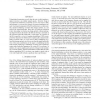Free Online Productivity Tools
i2Speak
i2Symbol
i2OCR
iTex2Img
iWeb2Print
iWeb2Shot
i2Type
iPdf2Split
iPdf2Merge
i2Bopomofo
i2Arabic
i2Style
i2Image
i2PDF
iLatex2Rtf
Sci2ools
ICASSP
2011
IEEE
2011
IEEE
Beating nyquist through correlations: A constrained random demodulator for sampling of sparse bandlimited signals
Technological constraints severely limit the rate at which analog-todigital converters can reliably sample signals. Recently, Tropp et al. proposed an architecture, termed the random demodulator (RD), that attempts to overcome this obstacle for sparse bandlimited signals. One integral component of the RD architecture is a white noiselike, bipolar modulating waveform that changes polarity at a rate equal to the signal bandwidth. Since there is a hardware limitation to how fast analog waveforms can change polarity without undergoing shape distortion, this leads to the RD also having a constraint on the maximum allowable bandwidth. In this paper, an extension of the RD, termed the constrained random demodulator (CRD), is proposed that bypasses this bottleneck by replacing the original modulating waveform with a run-length limited (RLL) modulating waveform that changes polarity at a slower rate than the signal bandwidth. One of the main contributions of the paper is establishing that the ...
| Added | 21 Aug 2011 |
| Updated | 21 Aug 2011 |
| Type | Journal |
| Year | 2011 |
| Where | ICASSP |
| Authors | Andrew Harms, Waheed U. Bajwa, A. Robert Calderbank |
Comments (0)

